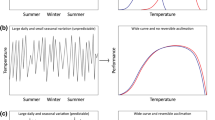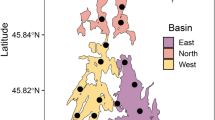Synopsis
Although a growing body of evidence has indicated that tuna can thermoregulate and have body temperatures that are decoupled from immediate changes in ambient temperature, demonstrating the extent and time-course of body temperature changes in tuna moving through their natural environments has proved to be elusive. Here we use body temperature data telemetered from free-ranging fish to demonstrate short-latency physiological thermoregulation in bigeye tuna. We used a recently developed modeling system to determine the magnitude and time-course of the whole-body thermal conductivity changes that would result in the body temperature changes observed in fish in the wild. The results indicate rapid, 100 to 1000-fold changes in whole-body thermal conductivity that occur in response to quickly changing ambient temperatures. Coupling this physiological response with behavioral thermoregulation expands the foraging space of these animals by permitting activity in wide ranges of water temperatures and depths.
Similar content being viewed by others
References cited
Axelsson, M. & S. Nilsson. 1986. Pressure control during exercise in the Atlantic Cod. J. Exp. Biol. 126: 225–236
Barrett, I. & F.J. Hester. 1964. Body temperature of yellowfin and skipjack tunas in relation to sea surface temperature. Nature 203: 96–97
Carey, F.G. 1973. Fishes with warm bodies. Sci. Amer. 228: 36–44
Carey, F.G. & K.D. Lawson. 1973. Temperature regulation in free swimming bluefin tuna. Comp. Biochem. Physiol. 44A: 375–392
Dizon, A.E. & R.W. Brill. 1979. Thermoregulation in tunas. Amer. Zool. 19: 249–265
Dizon, A.E., T.C. Byles & E.D. Stevens. 1976. Perception of abrupt temperature decreases by restrained skipjack tuna,Katsuwonus pelamis. J. Thermal. Biol. 1: 185–187
Graham, J.B. 1983. Heat transfer. pp. 248–279.In: P.W. Webb & D. Weihs (ed.) Fish Biomechanics, Praeger, New York
Graham, J.B. 1975. Heat exchange in the yellowfin tuna,Thunnus albacares and the skipjack tunaKatsuwonus pelamis, and the adaptive significance of elevated body temperatures in scombrid fishes. U.S. Fish. Bull. 73: 219–229
Graham, J.B. & K.A. Dickson. 1981. Physiological thermoregulation in the albacoreThunnus alalunga. Physiol. Zool. 54: 470–486
Graham, J.B. & D.R. Diener. 1978. Comparative morphology of the central heat exchangers in the skipjacksKatsuwonus andEuthynnus. pp. 113–134.In: G.D. Sharp & A.E. Dizon (ed.) The Physiological Ecology of Tunas, Academic Press, New York
Griewank, A. & G.F. Corliss. 1991. Automatic differentiation in algorithms: theory, practice, and application. SIAM, Philadelphia
Holland, K.N., R.W. Brill, J.R. Sibert & D.A. Fournier. 1992. Physiological and behavioral thermoregulation in bigeye tunaThunnus obesus. Nature 358: 410–412
Holland, K.N., R.W. Brill & R.K.C. Chang. 1990. Horizontal and vertical movements of yellowfin and bigeye tuna associated with fish aggregating devices. U.S. Fish. Bull. 88: 493–507
Holland, K.N., R.W. Brill, R.K.C. Chang & R. Yost. 1985. A small vessel technique for tracking pelagic fish. Mar. Fish. Rev. 47: 26–32
Neill, W H. & E.D. Stevens. 1974. Thermal inertia versus thermoregulation in ‘warm’ turtles and tuna. Science 184: 1008
Steffel, S., A.E. Dizon, J.J. Magnuson & W.H. Neill. 1976. Temperature discrimination by captive, free swimming tunaEuthynnus affinis. Trans. Amer. Fish. Soc. 105: 588–591
Stevens, E.D. & W.H. Neill. 1978. Body temperature relations of tunas, especially skipjack. pp. 315–359.In: W.S. Hoar & D.J. Randall (ed.) Fish Physiology, Volume 7, Academic Press, New York
Stevens, E.D., H.M. Lam & J. Kendall. 1974. Vascular anatomy of the counter-current heat exchanger of skipjack tuna. J. Exp. Biol. 61: 145–153
Author information
Authors and Affiliations
Additional information
Paper from the International Union of Biological Societies symposium ‘The biology of tunas and billfishes: an examination of life on the knife edge’, organized by Richard W. Brill and Kim N. Holland.
Rights and permissions
About this article
Cite this article
Holland, K.N., Sibert, J.R. Physiological thermoregulation in bigeye tuna,Thunnus obesus . Environ Biol Fish 40, 319–327 (1994). https://doi.org/10.1007/BF00002520
Received:
Accepted:
Issue Date:
DOI: https://doi.org/10.1007/BF00002520




